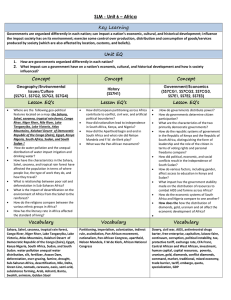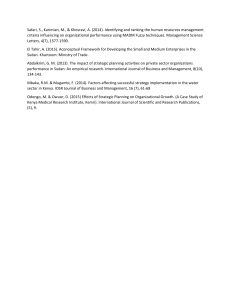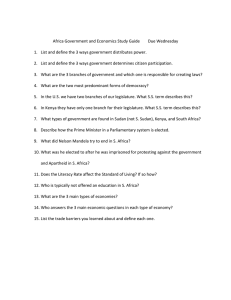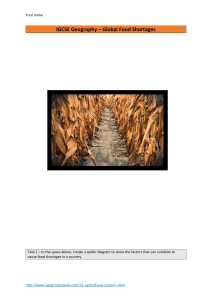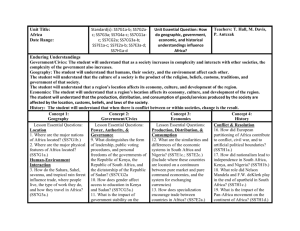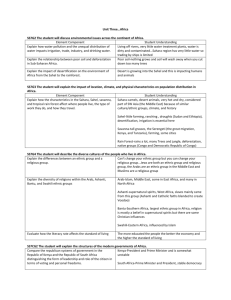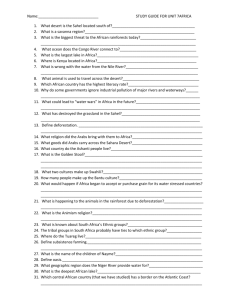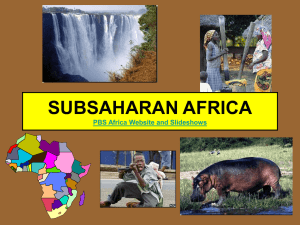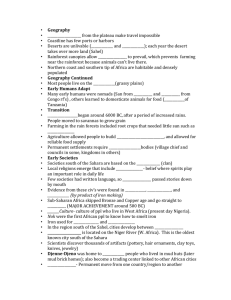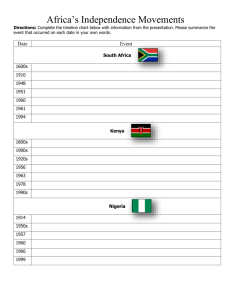AFRICA HANDBOOK REVIEW Create an Africa Handbook over all
advertisement
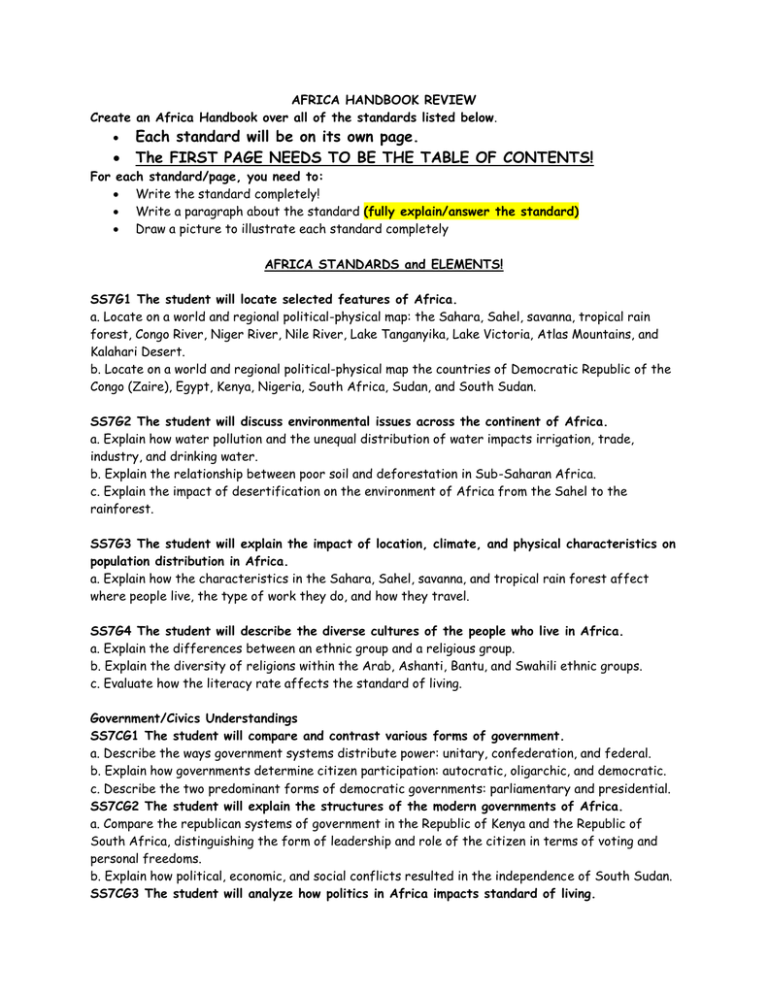
AFRICA HANDBOOK REVIEW Create an Africa Handbook over all of the standards listed below. Each standard will be on its own page. The FIRST PAGE NEEDS TO BE THE TABLE OF CONTENTS! For each standard/page, you need to: Write the standard completely! Write a paragraph about the standard (fully explain/answer the standard) Draw a picture to illustrate each standard completely AFRICA STANDARDS and ELEMENTS! SS7G1 The student will locate selected features of Africa. a. Locate on a world and regional political-physical map: the Sahara, Sahel, savanna, tropical rain forest, Congo River, Niger River, Nile River, Lake Tanganyika, Lake Victoria, Atlas Mountains, and Kalahari Desert. b. Locate on a world and regional political-physical map the countries of Democratic Republic of the Congo (Zaire), Egypt, Kenya, Nigeria, South Africa, Sudan, and South Sudan. SS7G2 The student will discuss environmental issues across the continent of Africa. a. Explain how water pollution and the unequal distribution of water impacts irrigation, trade, industry, and drinking water. b. Explain the relationship between poor soil and deforestation in Sub-Saharan Africa. c. Explain the impact of desertification on the environment of Africa from the Sahel to the rainforest. SS7G3 The student will explain the impact of location, climate, and physical characteristics on population distribution in Africa. a. Explain how the characteristics in the Sahara, Sahel, savanna, and tropical rain forest affect where people live, the type of work they do, and how they travel. SS7G4 The student will describe the diverse cultures of the people who live in Africa. a. Explain the differences between an ethnic group and a religious group. b. Explain the diversity of religions within the Arab, Ashanti, Bantu, and Swahili ethnic groups. c. Evaluate how the literacy rate affects the standard of living. Government/Civics Understandings SS7CG1 The student will compare and contrast various forms of government. a. Describe the ways government systems distribute power: unitary, confederation, and federal. b. Explain how governments determine citizen participation: autocratic, oligarchic, and democratic. c. Describe the two predominant forms of democratic governments: parliamentary and presidential. SS7CG2 The student will explain the structures of the modern governments of Africa. a. Compare the republican systems of government in the Republic of Kenya and the Republic of South Africa, distinguishing the form of leadership and role of the citizen in terms of voting and personal freedoms. b. Explain how political, economic, and social conflicts resulted in the independence of South Sudan. SS7CG3 The student will analyze how politics in Africa impacts standard of living. a. Compare how various factors, including gender, affect access to education in Kenya and Sudan. b. Describe the impact of government stability on the distribution of resources to combat AIDS and famine across Africa. Economic Understandings SS7E1 The student will analyze different economic systems. a. Compare how traditional, command, and market economies answer the economic questions of (1) what to produce, (2) how to produce, and (3) for whom to produce. b. Explain how most countries have a mixed economy located on a continuum between pure market and pure command. c. Compare and contrast the economic systems in South Africa and Nigeria. SS7E2 The student will explain how voluntary trade benefits buyers and sellers in Africa. a. Explain how specialization encourages trade between countries. Compare and contrast different types of trade barriers, such as tariffs, quotas, and embargos. b. Explain why international trade requires a system for exchanging currencies between nations. SS7E3 The student will describe factors that influence economic growth and examine their presence or absence in Nigeria and South Africa. a. Explain the relationship between investment in human capital (education and training) and gross domestic product (GDP). b. Explain the relationship between investment in capital (factories, machinery, and technology) and gross domestic product (GDP). c. Explain how the distribution of diamonds, gold, uranium, and oil affects the economic development of Africa. d. Describe the role of entrepreneurship. SS7H1 The student will analyze continuity and change in Africa leading to the 21st century. a. Explain how the European partitioning across Africa contributed to conflict, civil war, and artificial political boundaries. b. Explain how nationalism led to independence in South Africa, Kenya, and Nigeria. c. Explain the creation and end of apartheid in South Africa and the roles of Nelson Mandela and F.W.de Klerk. d. Explain the impact of the Pan-African movement.
